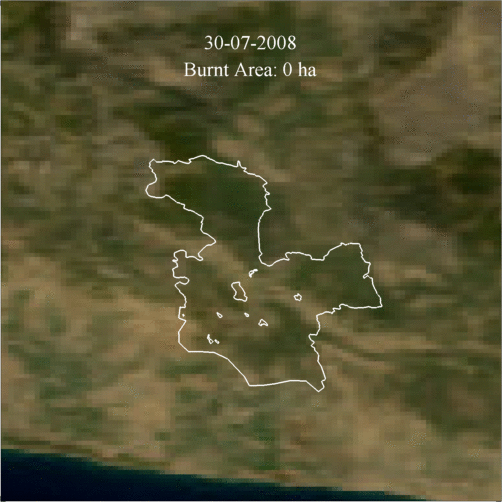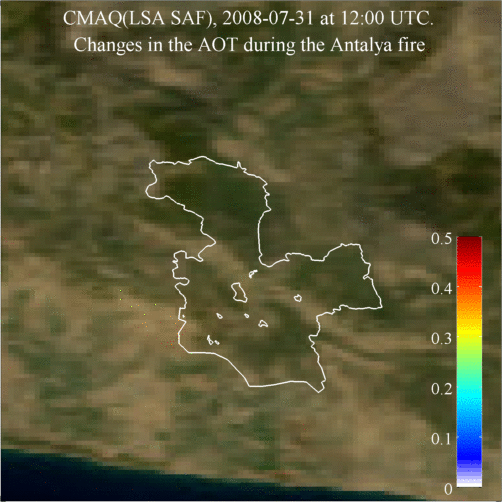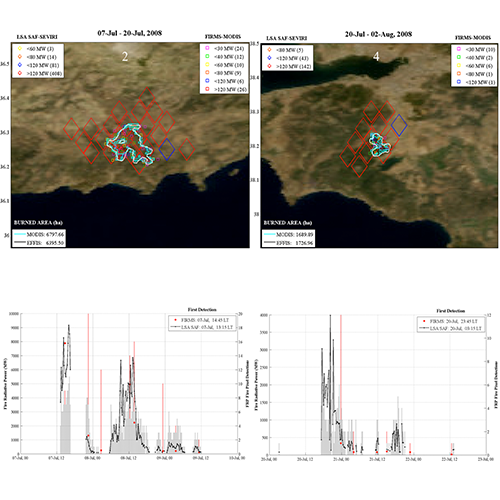Analysis
Biomass burning is a natural process in many ecosystems, but is greatly influenced by human activity and also by climate change (Marlon et al., 2008; Bowman et al., 2009). In many parts of the world, fire is used intentionally in agricultural practices. Vegetation burning can be an important part of a healthy ecosystem, but burning in some cases can scar an ecosystem when not properly managed. In fact fire is the main cause of forest destruction in the countries of the Mediterranean basin (JRC, 2008), where the fire season starts in April and can last until the end of November.
Biomass burning plays a key role in public health and environmental issues. Fires contribute to the build-up of atmospheric carbon dioxide (CO2) and emit other greenhouse gases and are a major source of aerosols (in particular black carbon and organic carbon), carbon monoxide (CO), oxides of nitrogen (NOx) and other reactive trace gases, impacting local and regional air quality (Kaiser at al., 2012). The degree of human exposure depends on the fire location, amount of fuel burned, type of fire, and the atmospheric transport of and chemistry in the plume.
For over 30 years meteorological and environmental satellites have been utilized to detect, monitor, and characterize fires:
- Fire weather forecasters use these products in combination with other meteorological data to provide more informed forecasts to those involved in fire fighting efforts.
- Satellite fire data can provide a consistent source of fire locations that can be applied to climate change analyses and land use and land cover change studies.
- Satellite observed fires have applications in air quality forecasting and air quality research where they can be applied to model active fire emissions in near real-time.
For the majority of the countries, very few information are available on fire frequencies, location and extension. For few of them the only available information about fire frequencies it has been primarily related to wild fires, which are those reported by forest agencies on the provincial and regional level (most of the time difficult to obtain and often not digitized). But biomass burning is a broader phenomenon. For example, at the end of the summer, it is common practice in agricultural regions in the mid-latitudes, to burn croplands after the harvest. Satellite fire products, in contrast to forest agency reports, are not selective in the type of fire observed and recorded. If the signal is strong enough to make it observable by a satellite platform, an agricultural fire will be recorded as well as a forest fire.
Emissions from open-vegetation burnings are increasingly recognized as an important parameter in atmospheric modeling, and their accurate description is important for specific regions and seasons as well as for specific episodes (Baldassarre et al., 2015). Recent studies have demonstrated that open biomass-burning events, although episodic, may have important effects on the photochemistry in the eastern Mediterranean (Poupkou et al., 2014). Furthermore, the impact of biomass burning is expected to become more important in the southeastern Mediterranean according to future scenarios on climate change (Tolika et al., 2012; Migliavacca et al., 2013).
This project aims to provide an overview of the most recent satellite based fire characterization products, by investigating their potential in describing biomass burning phenomena over Turkey in terms of their occurrence, location, extension intensity and emissions of main pollutants.
By exploring the potential of satellite techniques in describing biomass burnings over Turkey we aim to provide recommendations and methodology to implement satellite based fire characterization data in the different fields listed above. Satellite technology as well as modeling and forecasting techniques that correctly utilize satellite data can be beneficial in terms of forming a better understanding of issues such as air pollution or land use changes associated with burning. Furthermore, improving the information that decision makers receive facilitates better informed policy decisions impacting long term public health and environmental issues in a cost effective way.



